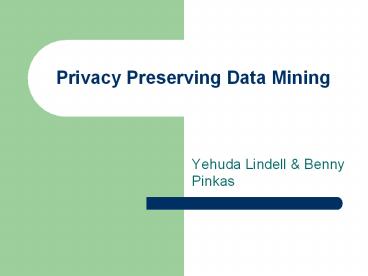Privacy Preserving Data Mining PowerPoint PPT Presentation
Title: Privacy Preserving Data Mining
1
Privacy Preserving Data Mining
- Yehuda Lindell Benny Pinkas
2
Summary
- Objective
- Various components / tools needed
- Algorithm
3
Objective
- Perform Data-mining on union of two private
databases - Data stays private i.e. no party learns anything
but output
4
Assumptions
- Large Databases Generic Solutions not possible
- Semi-Honest Parties
5
Classification by Decision Tree Learning
- ltattribute,valuegt
Attributes
Class Attribute
Want to Predict Class, using only non-class
attributes
Transaction
6
Decision Tree
- Rooted tree with nodes/edges
- Internal Nodes gt Attributes
- Edges leaving nodes gt Possible values
- Leaves gt Expected Class for transaction
- Traverse tree using known attributes
- Predict class given leaf nodes value
7
Constructing Tree
- Top-down
- At each level find attribute that best
classifies transactions gt gives least overhead - Best gt Attribute that minimizes entropy
(maximizes information gain) - Entropy -xlnx
- Entropy of class 0
8
Entropy calcluations
- Entropy H(T) sum (-x ln x )
- Hc(T) gt Info needed to ID class of transaction T
- X set of transactions for each class
- Sum over all possible classes
- Hc(T A) gt Info needed to ID class of
transaction T, Given value v of attribute A - X transactions with value v for attribute A
- Gain Hc(T) Hc(T A)
9
Private Computation
- Given only x1 and f1(x1,y), function S1 exists
s.t. - P2 provides input x1 to P1
- P2 can compute corresponding view of P1s DB
(desired ltatt,valuegt pairs)
S1
View
Party 2
f1(x1,y)
x1
f1
Party 1
10
Oblivious Evaluation
- What if in previous example Party 2 does not
want Party 1 to know what input (x1) it is
providing? - Oblivious Evaluation Receiver obtains P(x)
without learning anything else about polynomial
P. Sender learns nothing about x.
11
Oblivious Evaluation (2) Simplified Version
- ri receivers random number
- Ri senders random number
- X input from rcvr
- Sender Receiver
- s (secret key)
- (ari, asrj ax)
- (aRi, asR aP(x) asri)
Divide 2nd element by 1st element raised to power
s to get P(x)
a P(x) (aRi, asR aP(x) asri) /
(aRi ari)s
12
Algorithm
- Step 1 - Each party computes ID3 decision tree
learning (O( attributes)) - Step 2 - Combine results using cryptographic
protocols like oblivious evaluation -
(O(log(transactions))) - Result - Each party gains results of data-mining
without learning more than necessary
13
Algorithm (2)Finding best attribute is hardest
part
- Each party computes their share of entropy
- For each attribute, combine values from each
party - Results in private computation of Entropy (-xlnx)
- Choose attribute that minimizes entropy
- Provides maximum information gain
- Ensures most efficient tree with least overhead
- Use oblivious Evaluation
14
Discussion of Algorithm
- Efficient
- Large Databases accommodated Algorithm relies on
number of possible values for attributes NOT
number of transactions in database - Private
- Each step depends on local computation and
private protocol - Uses techniques like oblivious transfer /
evaluation to exchange information - Paper proves individual steps are private, AND
can predict control flow between steps ONLY based
on input/output so also private
15
Discussion of Algorithm (2)
- Approximate ID3 used instead of actual ID3
shown to be as secure and provide same information

